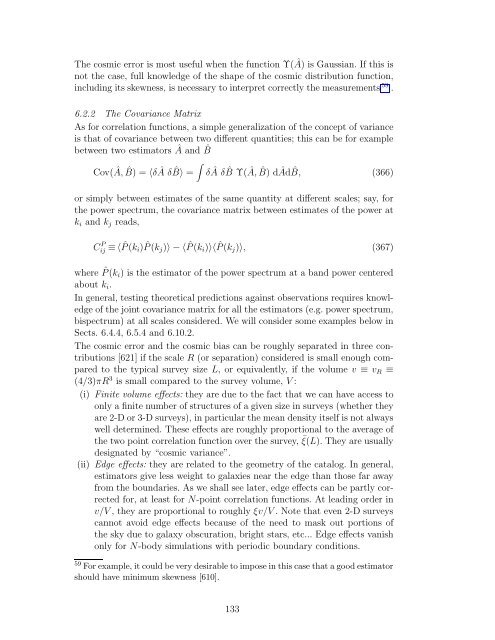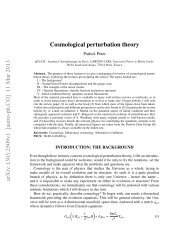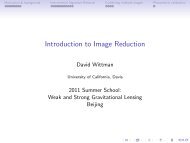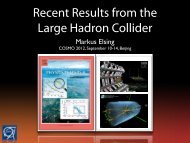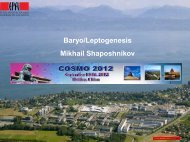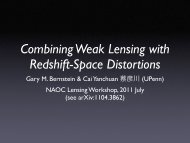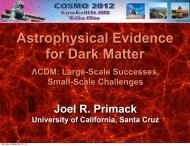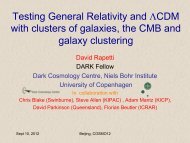Large-Scale Structure of the Universe and Cosmological ...
Large-Scale Structure of the Universe and Cosmological ...
Large-Scale Structure of the Universe and Cosmological ...
You also want an ePaper? Increase the reach of your titles
YUMPU automatically turns print PDFs into web optimized ePapers that Google loves.
The cosmic error is most useful when <strong>the</strong> function Υ( Â) is Gaussian. If this is<br />
not <strong>the</strong> case, full knowledge <strong>of</strong> <strong>the</strong> shape <strong>of</strong> <strong>the</strong> cosmic distribution function,<br />
including its skewness, is necessary to interpret correctly <strong>the</strong> measurements 59 .<br />
6.2.2 The Covariance Matrix<br />
As for correlation functions, a simple generalization <strong>of</strong> <strong>the</strong> concept <strong>of</strong> variance<br />
is that <strong>of</strong> covariance between two different quantities; this can be for example<br />
between two estimators  <strong>and</strong> ˆ B<br />
Cov( Â, ˆ B) = 〈δÂ δ ˆ <br />
B〉 = δÂ δ ˆ B Υ( Â, ˆ B) dÂd ˆ B, (366)<br />
or simply between estimates <strong>of</strong> <strong>the</strong> same quantity at different scales; say, for<br />
<strong>the</strong> power spectrum, <strong>the</strong> covariance matrix between estimates <strong>of</strong> <strong>the</strong> power at<br />
ki <strong>and</strong> kj reads,<br />
C P ij ≡ 〈 ˆ P(ki) ˆ P(kj)〉 − 〈 ˆ P(ki)〉〈 ˆ P(kj)〉, (367)<br />
where ˆ P(ki) is <strong>the</strong> estimator <strong>of</strong> <strong>the</strong> power spectrum at a b<strong>and</strong> power centered<br />
about ki.<br />
In general, testing <strong>the</strong>oretical predictions against observations requires knowledge<br />
<strong>of</strong> <strong>the</strong> joint covariance matrix for all <strong>the</strong> estimators (e.g. power spectrum,<br />
bispectrum) at all scales considered. We will consider some examples below in<br />
Sects. 6.4.4, 6.5.4 <strong>and</strong> 6.10.2.<br />
The cosmic error <strong>and</strong> <strong>the</strong> cosmic bias can be roughly separated in three contributions<br />
[621] if <strong>the</strong> scale R (or separation) considered is small enough compared<br />
to <strong>the</strong> typical survey size L, or equivalently, if <strong>the</strong> volume v ≡ vR ≡<br />
(4/3)πR 3 is small compared to <strong>the</strong> survey volume, V :<br />
(i) Finite volume effects: <strong>the</strong>y are due to <strong>the</strong> fact that we can have access to<br />
only a finite number <strong>of</strong> structures <strong>of</strong> a given size in surveys (whe<strong>the</strong>r <strong>the</strong>y<br />
are 2-D or 3-D surveys), in particular <strong>the</strong> mean density itself is not always<br />
well determined. These effects are roughly proportional to <strong>the</strong> average <strong>of</strong><br />
<strong>the</strong> two point correlation function over <strong>the</strong> survey, ¯ ξ(L). They are usually<br />
designated by “cosmic variance”.<br />
(ii) Edge effects: <strong>the</strong>y are related to <strong>the</strong> geometry <strong>of</strong> <strong>the</strong> catalog. In general,<br />
estimators give less weight to galaxies near <strong>the</strong> edge than those far away<br />
from <strong>the</strong> boundaries. As we shall see later, edge effects can be partly corrected<br />
for, at least for N-point correlation functions. At leading order in<br />
v/V , <strong>the</strong>y are proportional to roughly ξv/V . Note that even 2-D surveys<br />
cannot avoid edge effects because <strong>of</strong> <strong>the</strong> need to mask out portions <strong>of</strong><br />
<strong>the</strong> sky due to galaxy obscuration, bright stars, etc... Edge effects vanish<br />
only for N-body simulations with periodic boundary conditions.<br />
59 For example, it could be very desirable to impose in this case that a good estimator<br />
should have minimum skewness [610].<br />
133


